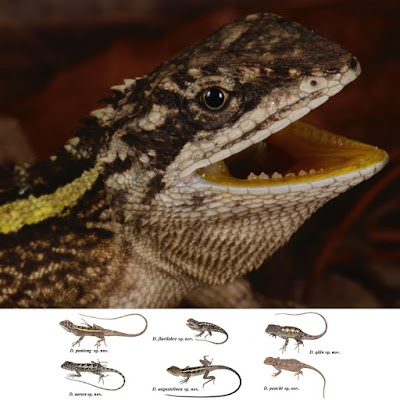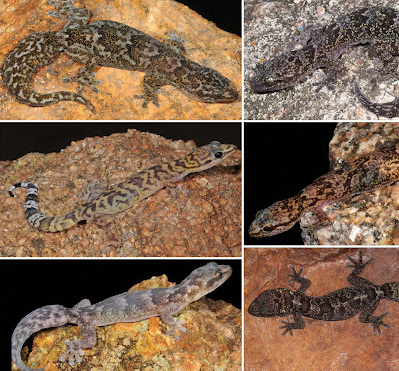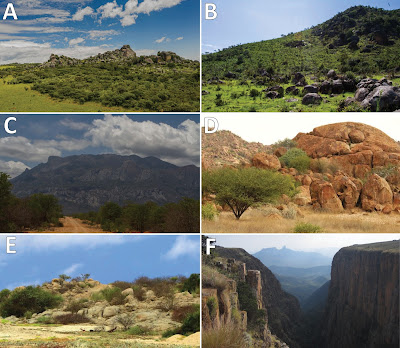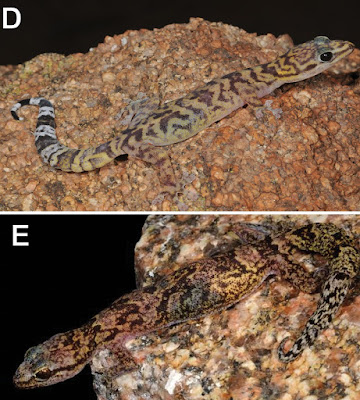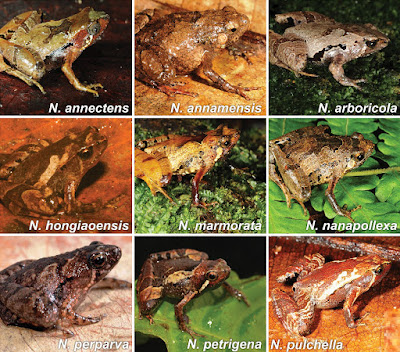[Most Recent Entries] [Calendar View]
Wednesday, January 13th, 2021
| Time | Event | ||
| 10:22a | [Herpetology • 2021] Systematic Revision of Mountain Dragons (Reptilia: Agamidae: Diploderma) in China, with Descriptions of Six New Species and Discussion on Their Conservation
Abstract Cryptic diversity not only introduces confusion to taxonomic studies, but it also poses major challenges to conservation and environmental legislation. One such troubling group are the Mountain Dragons in the genus Diploderma in Southwest China. Previous studies have suggested that the genus contains considerable cryptic diversity, particularly in the D. flaviceps complex. Owing to taxonomic confusion, micro‐endemic lineages are still neglected by the Chinese wildlife protection laws, despite their urgent conservation needs. Combining multivariate morphological and multi‐locus phylogenetic data, we provide the first integrative systematic revision of the genus Diploderma. Specifically, we confirm that the six examined populations of D. cf. flaviceps from the upper Jinsha and Yalong River Valleys in Sichuan and Yunnan Provinces represent six cryptic, undescribed lineages, and we describe each of them as a new species. With the updated taxonomy and distribution information, we discuss the taxonomy of the D. flaviceps complex in Southwest China, provide an updated diagnostic key along with distributional ranges for all species of the genus, and discuss some of the suspicious records of other congeners in China. Lastly, we evaluate the IUCN status of each of the six new species and highlight the major challenges for Diploderma conservation in China due to delayed environmental legislation and misleading conservation assessments. Keywords: Draconinae, IUCN, Japalura sensu lato, taxonomy, Wildlife Protection Act of China Diploderma angustelinea sp. nov. Wang, Ren, Wu, Che, Siler Etymology: The Latin specific name, “angustelinea”, comprises two parts: anguste meaning “narrow” and linea meaning “stripe” or “line.” Together, the specific name describes the diagnostic narrow, thin, dorsolateral stripes present in the species. We recommend Narrow‐striped Mountain Dragon as its English common name and 细纹龙蜥 (Pinyin: Xi Wen Long Xi) as its Chinese common name. Diploderma aorun sp. nov. Wang, Jiang, Zheng, Xie, Che, Siler Etymology: The species name “aorun” is derived from the name of the legendary Dragon Lord in Chinese mythology (Chinese 敖闰, Pinyin: Ao Run), who is the guardian of the West Ocean and is responsible for creating precipitation. We name the new species after the guardian of the ocean in the hope that the recognition of its endangered status will bring protection to the fragile valley habitats that the species is endemic to, just like the dragon lord protecting its realm in the mythology. We recommend Aorun Mountain Dragon as its English common name and 敖闰龙蜥 (Pinyin: Ao Run Long Xi) as its Chinese common name. Diploderma flavilabre sp. nov. Wang, Che, Siler Etymology: The Latin species name, flavilabre, means “yellow‐lipped,” which describes the diagnostic dark spectrum yellow coloration of inner lips of the species. We recommend Yellow‐lipped Mountain Dragon as its English common name and 黄唇龙蜥 (Pinyin: Huang Chun Long Xi) as its Chinese common name. Diploderma panchi sp. nov. Wang, Zheng, Xie, Che, Siler Etymology: The species name “panchi” is derived from the name of female dragons (Chinese蟠螭, Pinyin: Pan Chi) in the ancient Chinese literature,《汉书·司马相如传》. We recommend Panchi Mountain Dragon as its English common name and 蟠螭龙蜥(Pinyin: Pan Chi Long Xi) as its Chinese common name. Etymology: The specific name “panlong” is derived from the Chinese word 蟠龙 (Pinyin: Pan Long), from the ancient Chinese literature,《广雅》(Pinyin: Guang Ya). The name refers to dragons that are terrestrial and are not able to fly, which matches the terrestrial lifestyle of the new species. We recommend Pan Long Mountain Dragon as its English common name and 蟠龙龙蜥 (Pinyin Pan Long Long Xi) as its Chinese common name. Diploderma qilin sp. nov. Wang, Ren, Che, Siler Etymology: The specific name, qilin, is derived from the Chinese name of the legendary beast (麒麟). According to Chinese mythology, Qilin is the son of the dragon, with a golden yellow body coloration, which matches the diagnostic gular color of the new species. We suggest its English common name as Qilin Mountain Dragon and Chinese common name as 麒麟龙蜥 (Pinyin: Qi Lin Long Xi). Kai Wang, Jinlong Ren, Jiawei Wu, Ke Jiang, Jieqiong Jin, Shaobing Hou, Puyang Zheng, Feng Xie, Cameron D. Siler and Jing Che. 2021. Systematic Revision of Mountain Dragons (Reptilia: Agamidae: Diploderma) in China, with Descriptions of Six New Species and Discussion on Their Conservation. Journal of Zoological Systematics and Evolutionary Research. 59(1); 222-263. DOI: 10.1111/jzs.12414 Combining multi‐locus genetic and morphological data, we present the most comprehensive phylogeny of the genus Diploderma and provide the first systematic revision of the D. flaviceps complex from Southwest China. As results, we describe six new species from the upper Jinsha and Yalong Valleys, provide IUCN conservation assessments for each new taxon, update the diagnostic key to all species of the genus, and discuss current conservation challenges the genus in China due to the unsettled taxonomy, misleading conservation assessments, and delayed law legislation. | ||
| 2:57p | [Herpetology • 2021] Rock Island Melody: A Revision of the Afroedura bogerti Loveridge, 1944 Group (Squamata: Gekkonidae), with Descriptions of Four New Endemic Species from Angola
Abstract Four new species of flat geckos in the Afroedura bogerti Loveridge, 1944 group are described from south-western and west-central Angola. The description of these new species significantly restricts the distribution range of typical A. bogerti, a morphologically very similar species, from which they differ genetically by 5.9–12% divergence for the mitochondrial 16S ribosomal RNA gene. Morphologically and genetically, Angolan Afroedura are divided into two main groups: a mostly south-western coastal group and a west-central inland/highland group. These two groups are further divisible into three and two subgroups respectively, all geographically isolated, differing by a combination of the following features: colouration, average adult size, number of mid-body scale rows, number of scale rows on dorsal and ventral surface of each tail verticil and if nostril scales are in contact or not. All five Angolan species are morphologically distinguishable and in agreement with the molecular results. An updated dichotomous key to the Afroedura transvaalica group is provided. The new discovery adds to a growing number of endemic Pro-Namib reptiles described from Angola in recent years. Key Words: Biodiversity hotspot, cryptic species, endemism, Gekkonidae, Reptilia Afroedura bogerti Loveridge, 1944 Namba or Bogert’s Flat Gecko Osga-achadata da Namba, ou osga-achatada de Bogert Natural history and habitat: (Fig. 4A). An exclusively rupicolous species sheltering in crevices and under flakes of exfoliating rock amongst large granite boulders during the day. Individuals were observed at night foraging in vertical rock faces of large granite boulders. The surrounding habitat was mostly montane grasslands and some cultivated fields, but also included stunted altitude miombo and some Afromontane forest elements in steeper gorges and between boulders. It should be noted that the southern face of Namba Mountain contains the most extensive and well-preserved Afromontane forest patches in Angola, recognised as an important biodiversity reservoir and regional hotspot (Mills et al. 2013). Afroedura wulfhaackei sp. nov. Angolan Flat Gecko Osga-achatada de Angola Etymology: The new species is named in honour of Wulf Haacke, retired curator of the herpetology collection at the former Transvaal Museum (now Ditsong National Museum of Natural History). His herpetological expeditions to Angola in the early 1970s paved the way for this study and much of the material used in this study resulted from his expeditions. The name is constructed in the masculine singular genitive. Afroedura praedicta sp. nov. Serra da Neve Flat Gecko Osga-achatada da Serra da Neve Etymology: The specific epithet reflects the earlier prediction by William R. Branch of the potential existence of an isolated population of Afroedura at Serra da Neve. We use the specific epithet “praedicta”, the Latin participle meaning predicted or anticipated, formed in the feminine genitive to match the gender of Afroedura. Afroedura donveae sp. nov. Iona Flat Gecko Osga-achatada do Iona Etymology: This gecko is named after Donvé Branch, William R. Branch’s wife, with the following personal quote: “This, the most beautiful of all the Angolan flat geckos, is named for my wife, Donvé Branch (‘Dove’) who bore the long periods I was away on fieldwork, and to whose nest I returned, and surrounded me with love until the end”. The name is constructed in the feminine singular genitive. Afroedura vazpintorum sp. nov. Coastal Flat Gecko Osga-achatada da planície costeira Etymology: This species is named in honour of father and son, Pedro and Afonso Vaz Pinto, two enthusiastic Angolan naturalists with whom William R. Branch spent a great deal of time in the field, to recognise their contributions in collecting and studying Angolan herpetofauna. The name is constructed in the masculine plural genitive. William R. Branch, Andreas Schmitz, Javier Lobón-Rovira, Ninda L. Baptista, Telmo António and Werner Conradie. 2021. Rock Island Melody: A Revision of the Afroedura bogerti Loveridge, 1944 Group, with Descriptions of Four New Endemic Species from Angola. Zoosystematics and Evolution. 97(1): 55-82. DOI: 10.3897/zse.97.57202 Resumo: Aqui são descritas quatro novas espécies de osga-achatada, do grupo Afroedura Loveridge, 1944, do sudoeste e centro-oeste de Angola. A descrição destas novas espécies reduziu significativamente a área de distribuição da A. bogerti típica, uma espécie uma espécie morfologicamente muito semelhante às primeiras, da qual estas têm entre 5.9 e 12% de diferença genética para o gene mitocondrial 16S rRNA. Do ponto de vista morfológico e genético, as Afroedura de Angola dividem-se em dois grupos principais: o do sudoeste, maioritariamente das planícies costeiras e do norte, e o do planalto interior. Estes grupos podem ainda ser divididos em dois e três subgrupos, respectivamente, todos isolados geograficamente, e estes diferem entre si na combinação das seguintes características: coloração, tamanho médio dos adultos, número de fileiras de escamas na secção mediana do corpo, número de escamas dorsais e ventrais por cada anel caudal de escamas, escamas nasais em contacto ou não. É possível distinguir morfologicamente as cinco espécies de Angola, de forma concordante com os resultados da genética. Aqui apresentamos uma chave dicotómica actualizada para o grupo Afroedura transvaalica. Esta nova descoberta junta-se ao crescente número de répteis endémicos do Pro-Namibe descritos em Angola nos últimos anos. Palavras-chave: Еndemismo, espécies crípticas, Gekkonidae, hotspot de biodiversidade, Reptilia | ||
| 3:19p | [Herpetology • 2021] Nanohyla gen. nov. • Consequences of Parallel Miniaturisation in Microhylinae (Anura, Microhylidae), with the Description of A New Genus of Diminutive South East Asian Frogs
Abstract The genus Microhyla Tschudi, 1838 includes 52 species and is one of the most diverse genera of the family Microhylidae, being the most species-rich taxon of the Asian subfamily Microhylinae. The recent, rapid description of numerous new species of Microhyla with complex phylogenetic relationships has made the taxonomy of the group especially challenging. Several recent phylogenetic studies suggested paraphyly of Microhyla with respect to Glyphoglossus Günther, 1869, and revealed three major phylogenetic lineages of mid-Eocene origin within this assemblage. However, comprehensive works assessing morphological variation among and within these lineages are absent. In the present study we investigate the generic taxonomy of Microhyla–Glyphoglossus assemblage based on a new phylogeny including 57 species, comparative morphological analysis of skeletons from cleared-and-stained specimens for 23 species, and detailed descriptions of generalized osteology based on volume-rendered micro-CT scans for five species–altogether representing all major lineages within the group. The results confirm three highly divergent and well-supported clades that correspond with external and osteological morphological characteristics, as well as respective geographic distribution. Accordingly, acknowledging ancient divergence between these lineages and their significant morphological differentiation, we propose to consider these three lineages as distinct genera: Microhyla sensu stricto, Glyphoglossus, and a newly described genus, Nanohyla gen. nov. Key Words: Amphibians, integrative taxonomy, narrow-mouthed frogs, micro-computed tomography, Nanohyla gen. nov, osteology, sexual dimorphism, taxonomic revision Nanohyla Poyarkov, Gorin & Scherz, gen. nov. Chresonymy: Microhyla (partim)–Boulenger 1900; Smith 1923; Inger and Frogner 1979; Inger 1989; Bain and Nguyen 2004; Poyarkov et al. 2014; Hoang et al. 2020. Microhyla (Microhyla) (partim)–Dubois 1987 (as a part of the subgenus Microhyla). Type species: Microhyla annectens Boulenger, 1900. Etymology: The genus name is derived from the Greek νᾶνος (nanos), meaning “dwarf”, “pygmy”, and the mythological figure, Hylas (Ancient Greek: Ὕλας), which is probably derived from the Ancient Greek verb “ὕλαω” meaning “to bark” (Bourret 1942). In classical mythology, Hylas, son of King Theiodamas, was a youth who served as Heracles’ companion, lover, and servant. Heracles took Hylas with him on the Argonauts’ expedition, during which Hylas was kidnapped by nymphs of the spring in Pegae, Mysia, and turned into an echo. Heracles left the ship and was searching for Hylas for a great length of time, calling his name: “His adjunxit Hylan nautae quo fonte relictum / Clamassent ut littus Hyla! Hyla! omne sonaret” (“The mariners cried on Hylas till the shore / Then Re-echoed Hylas! Hylas! soothed...”; Virgil 1916, Ecl. 6, 43). The genus name refers to the small body size (< 25 mm) of all known Nanohyla species, while maintaining resemblance to its sister genus Microhyla, from which it is separated herein. The new genus name is feminine in gender. Suggested common name: Pygmy Narrow-mouthed Frogs. Taxonomic content: Nine species, including: Nanohyla annamensis comb. nov. (Smith, 1923); Nanohyla annectens comb. nov. (Boulenger, 1900); Nanohyla arboricola comb. nov. (Poyarkov, Vassilieva, Orlov, Galoyan, Tran, Le, Kretova & Geissler, 2014); Nanohyla hongiaoensis comb. nov. (Hoang, Nguyen, Luong, Nguyen, Orlov, Chen, Wang & Jiang, 2020); Nanohyla marmorata comb. nov. (Bain & Nguyen, 2004); Nanohyla nanapollexa comb. nov. (Bain & Nguyen, 2004); Nanohyla petrigena comb. nov. (Inger & Frogner, 1979); Nanohyla perparva comb. nov. (Inger & Frogner, 1979); and Nanohyla pulchella comb. nov. (Poyarkov, Vassilieva, Orlov, Galoyan, Tran, Le, Kretova & Geissler, 2014). Nanohyla annamensis (Smith, 1923); Nanohyla annectens (Boulenger, 1900); Nanohyla arboricola (Poyarkov, Vassilieva, Orlov, Galoyan, Tran, Le, Kretova & Geissler, 2014); Nanohyla hongiaoensis (Hoang, Nguyen, Luong, Nguyen, Orlov, Chen, Wang & Jiang, 2020); Nanohyla marmorata (Bain & Nguyen, 2004); Nanohyla nanapollexa (Bain & Nguyen, 2004); Nanohyla petrigena (Inger & Frogner, 1979); Nanohyla perparva (Inger & Frogner, 1979); Nanohyla pulchella (Poyarkov, Vassilieva, Orlov, Galoyan, Tran, Le, Kretova & Geissler, 2014). Diagnosis: The new genus is assigned to the subfamily Microhylinae on the basis of phylogenetic affinities and the following combination of morphological character states: vomers small, confined to the anterior and medial margins of choanae; clavicles and, in most cases, procoracoids absent, maxillary arcade edentate (Parker 1934). Nanohyla gen. nov. differs from other Microhylinae genera by the following combination of osteological character states: (1) frontoparietals fused with exoccipitals; (2) exoccipitals fused with each other (incomplete fusion in N. pulchella); (3) neopalatines present; (4) sphenethmoids completely fused with parasphenoid (incomplete fusion in N. pulchella); (5) crista parotica entirely cartilaginous; (6) otic ramus of squamosal well-developed; (7) tympanic annulus well-developed; (8) transverse processes of presacral vertebrae with the following orientation: IV and V posterolaterally, II, VII and VIII anterolaterally, III and VI at right angle to body axis; (9) clavicles absent; (10) omosternum present, cartilaginous; (11) prehallux cartilaginous; (12) terminal phalanges of longest fingers and toes T-shaped. The combination of diagnostic external morphological characters includes: (13) small to extremely small frogs (adult SVL 11.8–25.8 mm); (14) snout rounded or pointed in profile; (15) supratympanic fold present; (16) ridge on posterior sides of choanae absent; (17) first finger (FI) length less than ½ FII or reduced to a nub; (18) finger discs present, at least on FII–FIV; (19) dorsal median longitudinal grooves on finger discs generally present (with the exception of N. perparva); (20) toes dorsolaterally flattened, prominent discs present; (21) dorsal median longitudinal grooves on toe discs present; (22) metatarsal tubercle single (inner metatarsal tubercle present, outer absent); (23) dorsomedial line absent; (24) superciliary tubercles absent; (25) tibiotarsal articulation of adpressed hindlimb reaching well beyond snout; (26) toe webbing well-developed (at least one-half webbed); (27) skin on dorsum feebly granular to tubercular; (28) tympanum externally distinct at least in males (N. annamensis, N. annectens, N. arboricola, N. marmorata, N. nanapollexa, N. pulchella) or barely distinct (N. hongiaoensis, N. perparva, N. petrigena); (29) terrestrial or scansorial semi-arboreal microhabitat preference. Phylogenetic definition: The genus Nanohyla gen. nov. includes all species sharing a more recent common ancestor with Nanohyla annectens than with Microhyla achatina and Glyphoglossus molossus. Distribution: The distribution area of Nanohyla gen. nov. covers montane forests of the Annamite (Truong Son) Mountains in Vietnam, eastern Laos, and north-eastern Cambodia, the Titiwangsa Mountain Range in the southernmost Thailand and peninsular Malaysia, mountains of Borneo (including Sabah and Sarawak of Malaysia, Brunei, and Kalimantan of Indonesia) and the Sulu Archipelago of the Philippines (see Fig. 1). The occurrence of Nanohyla gen. nov. in Cardamom Mountains in eastern Thailand (the record of “M. annamensis” from Khao Sebab by Taylor [1962], see Fig. 1) is questionable (see Poyarkov et al. 2014, 2020a).  Conclusions: Miniaturized amphibians are characterized by a high proportion of cryptic species, along with numerous anatomical homoplasies, muddying our estimates of their evolutionary relationships and diversity (e.g., Hanken and Wake 1993; Rovito et al. 2013; Parra-Olea et al. 2016; Rakotoarison et al. 2017; Scherz et al. 2019; Gorin et al. 2020). Integrative taxonomic approaches, optimally combining the results of molecular phylogenetic analyses with morphological, acoustic and behavioral data, represent the most promising approach for better understanding of species boundaries, diversity and evolutionary relationships in microhylid frogs, including the genus Microhyla (Hasan et al. 2014; Garg et al. 2019; Poyarkov et al. 2018a, 2019; Gorin et al. 2020). Many recent phylogenetic studies of miniaturized frogs demonstrate that the diversity of these groups is unexpectedly high, at both the species and supraspecific levels, due to a combination of overlooked diversity (cryptic species) and microendemism (Oliver et al. 2017; Rakotoarison et al. 2017; Clemente-Carvalho et al. 2011; Poyarkov et al. 2018a; Zimkus et al. 2012; Blackburn et al. 2008; Lourenço-de-Moraes et al. 2018; Rodriguez et al. 2013; Köhler et al. 2008; Scherz et al. 2019). The present analysis of the Microhyla–Glyphoglossus assemblage diversity represents a case in point: miniaturized taxa, that were previously assigned ad hoc to Microhyla s. lat., were demonstrated to belong to two deeply divergent clades, together closely related to the genus Glyphoglossus, which consists of species of a much larger body size and very different ecology. Upon closer examination of their phylogenetic relationships from molecular data, as well as morphology, ecology, and biogeography, we found that these deep clades were older than most other Microhylinae genera, and sufficiently different to justify recognition as distinct genera. This yielded the new genus Nanohyla gen. nov. described herein. This result further underlines the importance of genetic data, useful for independently elucidating diversity and evolutionary relationships within groups with extensive homoplasies (Mott and Vieites 2009; Heideman et al. 2011; Scherz et al. 2019). The Microhyla–Glyphoglossus assemblage (perhaps better now called the Microhyla–Nanohyla–Glyphoglossus assemblage) shows highly dynamic body size evolution, and a propensity to miniaturize, with at least nine separate miniaturization events inferred across Microhyla and the new genus Nanohyla. Convergence in body size in these two genera has generated some homoplasies, but both have unique, apomorphic features. It is clear, however, that, in order to gain a comprehensive understanding of the evolution of miniaturization in these frogs, much more extensive sampling of outgroups is needed. The Microhylidae, however, form an ideal group in which to study the evolution of miniaturization, which is one of several phylogenetically recurring frog ecomorphs (Moen et al. 2015). Vladislav A. Gorin, Mark D. Scherz, Dmitriy V. Korost and Nikolay A. Poyarkov. 2021. Consequences of Parallel Miniaturisation in Microhylinae (Anura, Microhylidae), with the Description of A New Genus of Diminutive South East Asian Frogs. Zoosystematics and Evolution. 97(1): 21-54. DOI: 10.3897/zse.97.57968 |
| << Previous Day |
2021/01/13 [Calendar] |
Next Day >> |
